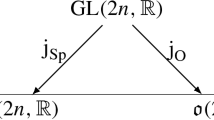Abstract
We prove that the set D of vector fields on the configuration space B of a field whose 1-parameter groups locally associated are groups of fibre-preserving transformations of B that leave invariant that field in the sense of variational theory, is a Lie algebra with respect to ordinary addition, multiplication by real numbers and Lie brackets. We see that this Lie algebra structure can be carried over to the corresponding set ℐ of Noether invariants, which then becomes a Lie algebra in a natural way.
Further, we define the “n-form of Poincaré-Cartan” of a field, and we use it to generalize the Lie algebras D and ℐ in a reasonable way. The algebras D and ℐ are subalgebras of the new Lie algebras D and ℐ′ introduced. A main result in this connection is the following: the differential dΘ of the n-form of Poincaré-Cartan Θ is −θ∧(dΩ+fοω), where (θ, dΩ+fοω) are the field equations on the vertical bundle B.
The “symplectic manifold of solutions” associated with a field is introduced in a formal way and the former Lie algebras D, ℐ, D′, ℐ′ are interpreted on this manifold. In imitation of the case of analytical dynamics, the main results in this direction are: a) Every vector field of the Lie algebra D′ defines, in a canonical way, a vector field on the manifold of solutions such that its polar 1-form with respect to the symplectic metric ω 2 is the differential of its corresponding Noether invariant, and b) the Lie bracket [ω, ω′] of two Noether invariants ω, ω′ ∈ ℐ′ is the Noether invariant given by ω 2(D, D′), where D, D′ are the vector fields on the manifold of solutions defined, in the sense a), by two infinitesimal generators of ω, ω′, respectively. This will allow us to regard the Lie algebra ℐ′ as the analogous object in field theory to the Poisson algebra of analytic dynamics.
We apply the general formalism to the relativistic theory of non-linear scalar fields, and we compare our results with the formalism developed by I. Segal for this case.
Similar content being viewed by others
References
Dirac, P. A. M., Lectures on Quantum Mechanics. New York: Belfer Graduate School of Science Monographs Series No. 2. 1964.
García, P. L., & A. Pérez-Rendon, Symplectic approach to the theory of quantized fields-I. Commun. Math. Phys. 13, 24 (1969).
García, P. L., Geometría simpléctica en la teoría clásica de campos. Collect. Math. 19, 1–2, 73 (1968).
García, P. L., Estructura compleja en la teorîa clásica de campos. Collect. Mat. 19, 3, 155 (1968).
Kobayashi, S., & K. Nomizu, Foundations of Differential Geometry, Vol.1. New York: Interscience 1963.
Segal, I. E., Quantization of non-linear systems. J. Math. Phys. 1, 6, 468 (1960).
Souriau, J. M., Quantification géométrique. Commun. Math. Phys. 1, 374 (1966).
Streater, R. F., Canonical quantization. Commun. Math. Phys. 2, 354 (1966).
Author information
Authors and Affiliations
Additional information
Communicated by C.-C. Wang
Rights and permissions
About this article
Cite this article
García, P.L., Pérez-Rendón, A. Symplectic approach to the theory of quantized fields. II. Arch. Rational Mech. Anal. 43, 101–124 (1971). https://doi.org/10.1007/BF00252774
Received:
Issue Date:
DOI: https://doi.org/10.1007/BF00252774




